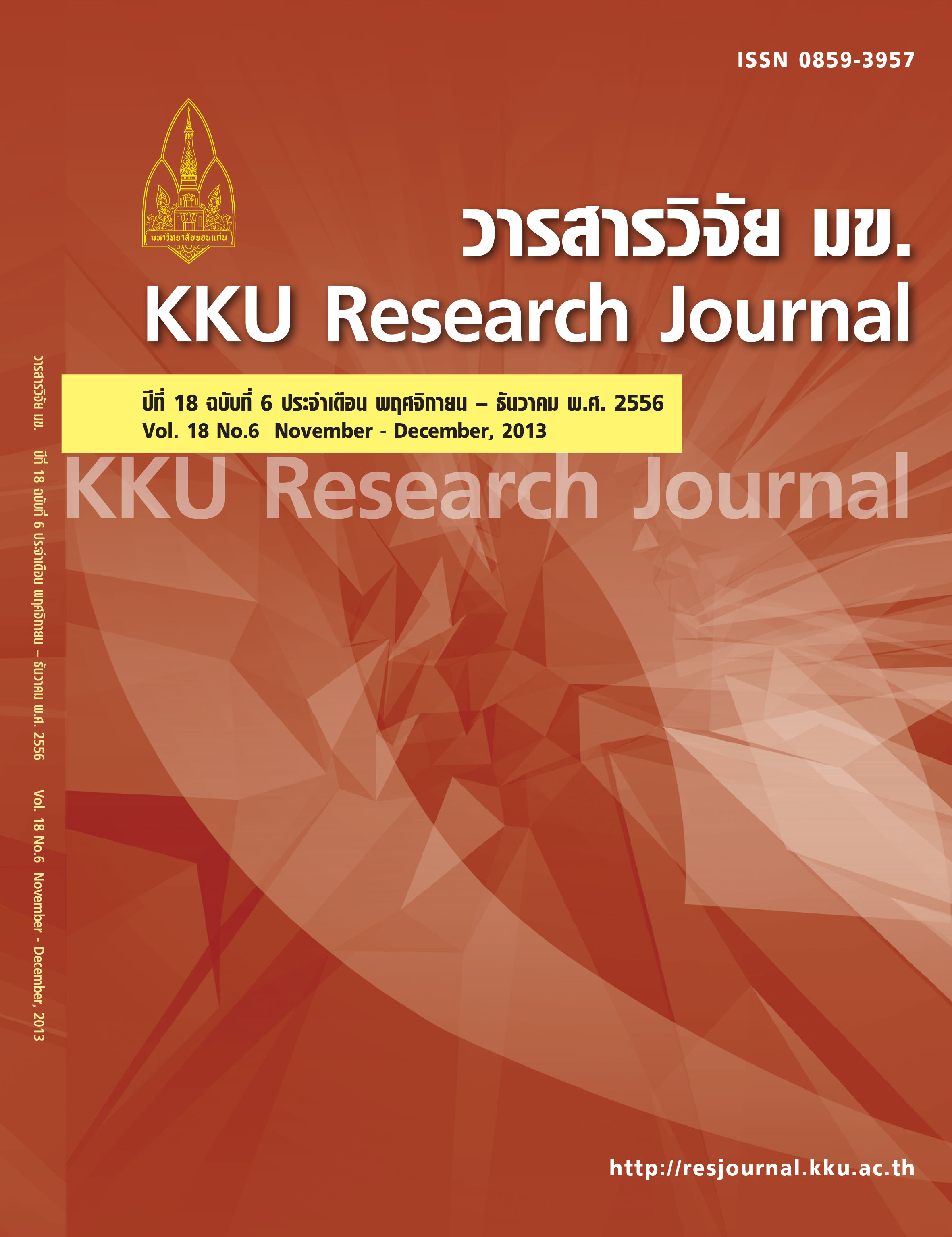The optimum density of sirindthorn fairy shrimp (Streptocephalus sirindhornae Sanoamuang, Murugan, Weekers and Dumont) culture system in earthen pond by using agricultural waste water and fermented rice noodle factory
Main Article Content
Abstract
The objectives of this study were to culture fairy shrimp Streptocephalus sirindhornae in earthen ponds at three stocking densities and three waste water sources. The experiments and Technology Transferwere conducted in Phang Khon district, Sakon Nakhon Province, Thailand. Ten-day old fairy shrimp with average body lengths ranging from 1.173?0.054 cm were used in each experiment with 3 replicates. After culturing the fairy shrimp for 20 days at stocking densities of 1x106, 2x106 and 3x106 individual rai-1had the average body lengths were 2.281?0.016, 1.929?0.034 and 1.943?0.098 cm and the average weight were 0.132?0.009, 0.121?0.010 and 0.100?0.002 g ind.-1, respectively. The experiment showed that the waste water sources of fish culture pond waste water, livestock waste water and factory noodles waste water had the average body lengths were 1.408?0.020, 1.245?0.046 and 1.263?0.028 cm, the average weight were 0.069?0.002, 0.064?0.001 and 0.597?0.001 g ind.-1, the average chlorophyll a were 41.83?1.662, 39.28?1.250 and 34.35?2.115 ?g L-1, the average carotenoid were 92.89?5.074, 82.80?2.974 and 61.68?2.098 ?g g-1 cell dry weight and the average protein were 64.80?1.570, 61.50?2.647 and 60.32?2.56 % cell dry weight, respectively.
Thus the most suitable condition to culture S. sirindhornae is in 1 rai (1,600 m3) pond at stocking densities of 1x106 ind. rai-1 (p<0.05) with the highest production of 21 g m-3. The highest survival rate of 63.62% (p<0.05) was recorded when cultured at 1x106 individual rai-1 (p<0.05). The most suitable condition to culture S. sirindhornae by waste water source was fish culture waste water (p<0.05) with the highest average of body length, weight, chlorophyll a, carotenoid and protein. In contrast, the sex ratios and total eggs per individual female reared in 3 difference stocking densities and 3 waste water sources were not significantly different (p>0.05). The advantage of rearing this fairy shrimp in earthen ponds is having viable egg banks in the bottom of the ponds. These eggs can be used as initial stocking animals for commercial cultures.
Article Details
References
(2) Sanoamuang L, Saengphan N, Murugan G.First record of the family Thamnocephalidae,(Crustacea, Anostraca) from Southeast Asia and description of a new species of Branchinella. Hydrobiologia 2002; 486: 63-69.
(3) Sornsupharp S, Dahms H-U, Sanoamuang L. Nutrition composition of fairy shrimp Streptocephalus sirindhornae nauplii as live food and growth performance of giant freshwater prawn postlarvae. Aquaculture Nutrition 2013; 19: 349-359.
(4) Sreeputhorn K, Sanoamuang L. Culture of the Thai fairy shrimp (Branchinella thailandensis Sanoamuang, Saengphan and Murugan, 2002) by bioextract and Yeast as food. Journal of Scientific Research (Section T). 2007; 6 special 1: 369-375. Thai
(5) Sriputhorn K. The study on culture of Thai fairy shrimp, Branchinella thailandensis by dry diet for Chlorella sp. Replacement. RMUTI Journal 2013; 6(1): 66-80. Thai
(6) Maeda-Martinez AM, Belk D, Obregon-Barboza H. Dumont HJ. Laboratory culture of fairy shrimps
using baker’s yeast as basic food in a fl ow-through system. Hydrobiologia 1995; 298: 141-159.
(7) Sriputhorn K. The Development of Fairy Shrimp Cultures, Branchinella Thailandensis and Streptocephalus Sirindhornae for Commercial Purposes and Using as Food for Giant Freshwater Prawns, Macrobrachium Rosenbergii [Doctor of Philosophy Thesis]. Khon Kaen: Khon Kaen University, 2009. Thai
(8) Sriputhorn K, Sanoamuang L. Growth and survival rate red Nile Tilapia (Oreochromis niloticus) and freshwater prawn (Macrobrachium rosenbergii) nursing by Thai fairy shrimp (Branchinella thailandensis). RMUTI Journal 2012A; 5(1): 1-13. Thai
(9) Tunsutapanich A, Puwapanich T, Sungkorntanakit T, Permngam T. Culture and applications of Artemia. Department of Fisheries, Ministry of Agriculture and Coorperation; 1993. Thai
(10) Sriputhorn K, Sanoamuang L. The fairy shrimp culture: Form innovation to creative economy. Khon Kaen: Klung Na Na Press; 2012A. Thai
(11) Saengphan N, Sriputhorn K, Sanoamuang L. Culture of Fairy shrimp in Thailand. Khon Kaen:
Klung Na Na Press; 2006. Thai


